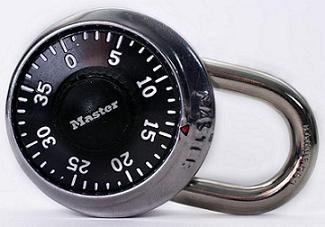当前你的浏览器版本过低,网站已在兼容模式下运行,兼容模式仅提供最小功能支持,网站样式可能显示不正常。
请尽快升级浏览器以体验网站在线编辑、在线运行等功能。
2957:Combination Lock
题目描述
The combination lock of this problem, as shown in the figure, consists of a circular dial, which can be turned (clockwise or counterclockwise) and is embedded into the "fixed" part of the lock. The dial has N evenly spaced "ticks". The ticks are numbered from 0 to N-1, increasing in the clockwise direction. The fixed part of the lock has a "mark" which always "points to" a particular tick on the dial. Of course, the mark points to different ticks as the dial is turned. (In the figure, N = 40 and the mark points to tick 14.)

The lock comes with three code numbers T1,T2, T3. These are non-negative integers and each of them is less than N. No two of the three are the same.
The lock is opened in three stages of operations:
1. If the mark initially points to tick T1, turn the dial exactly two full revolutions clockwise and stop. Otherwise, turn the dial clockwise exactly two full revolutions, and continue to turn it clockwise until the mark points to tick T1.
2. Turn the dial one full revolution counterclockwise and continue to turn it counterclockwise until the mark points to tick T2.
3. Turn the dial clockwise until the mark points to tick T3. The lock should now open.
Given the numbers N, T1, T2, T3, the goal of this problem is to find the average number of ticks the dial must be turned in order to open the lock. For any particular N, T1, T2, T3 and a particular initial configuration of the lock, the number of ticks turned is defined to be the sum of the ticks turned in the three stages outlined above.

The lock comes with three code numbers T1,T2, T3. These are non-negative integers and each of them is less than N. No two of the three are the same.
The lock is opened in three stages of operations:
1. If the mark initially points to tick T1, turn the dial exactly two full revolutions clockwise and stop. Otherwise, turn the dial clockwise exactly two full revolutions, and continue to turn it clockwise until the mark points to tick T1.
2. Turn the dial one full revolution counterclockwise and continue to turn it counterclockwise until the mark points to tick T2.
3. Turn the dial clockwise until the mark points to tick T3. The lock should now open.
Given the numbers N, T1, T2, T3, the goal of this problem is to find the average number of ticks the dial must be turned in order to open the lock. For any particular N, T1, T2, T3 and a particular initial configuration of the lock, the number of ticks turned is defined to be the sum of the ticks turned in the three stages outlined above.
输入解释
The input file consists of a number of test cases, one test case per line. Each line of the input file contains four integers: N, T1, T2, T3, in this order, separated by blank spaces. The integer N is a multiple of 5, 25 <= N <= 100. The numbers T1, T2 and T3 satisfy the constraints stated under the description above. The input will be terminated by a line containing only four zeroes, separated by blank spaces.
输出解释
For each test case, print the average number of ticks (rounded to three decimal places) the dial must be turned in order to open the lock. Assume that each of the N possible initial configurations of the lock is equally likely.
输入样例
80 20 40 50 80 10 79 12 0 0 0 0
输出样例
369.500 415.500
来自杭电HDUOJ的附加信息
| Recommend | gaojie |
最后修改于 2020-10-25T22:58:39+00:00 由爬虫自动更新
共提交 0 次
通过率 --%
| 时间上限 | 内存上限 |
| 2000/1000MS(Java/Others) | 32768/32768K(Java/Others) |
登陆或注册以提交代码